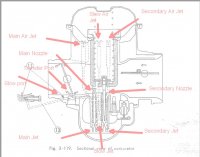SimonDanger
New Member
Ok, here's the thing...I'm newish here and it appears I'm also a bit of a masochist. I seem to like the almost woman-like complexity and, at times, contradictions, of the EPA-inspired Keihin CV carburetor. It intrigues me, so I dig deeper, ever trying to untangle the mystery of her inner thoughts, feelings and emotions 
It is these of which I speak:

I've always taken apart carburetors, regardless of their intimidating appearance, and managed to get a few back together as well. I just like the simple yet complex mechanics of these things. Even though I have been urged to never, ever, dispatch with the imperial airbox that is the black molded plastic lung through which these girls breath, I nonetheless charge head-long into the shadowy jungle passages in search of the heart of darkness. The horror; oh the horror. Inasmuch as I can, I want to take this forensic knowledge of this carb and try to tune my foursome into a smooth growl, from idle all the way thru WOT, by re-jetting my airboxless Keihins on my 750.
Having read endlessly everywhere I can find (this board, the interwebs, my service manual) and having disassembled my girls a few times already, I have yet to find a single drawing of just what the specific ports & jets in the Keihin VB42a look like. Sure, there are exploded views of the various parts that are specific to that model, and then there are the crude mspaint drawings showing the dumbed-down view of a generic carburetor. But no mechanical drawings or spec sheets of this carb...so I took matters into my own hands and drew this:

I make no assertions as to the quality of the above drawing...
It is my intention to seek the council of the experts here who have - shall I say - an intimate relationship with this carb and direct me as to how I might modify my drawing to more accurately reflect this carb's design. I'm most interested in where in the venturi the ports/jets lie in linear relation along the air-flow channel. If you see any glaring omissions/additions, please point them out. If you happen to know where a better drawing is, please post its link. 8)
Thanks
It is these of which I speak:

I've always taken apart carburetors, regardless of their intimidating appearance, and managed to get a few back together as well. I just like the simple yet complex mechanics of these things. Even though I have been urged to never, ever, dispatch with the imperial airbox that is the black molded plastic lung through which these girls breath, I nonetheless charge head-long into the shadowy jungle passages in search of the heart of darkness. The horror; oh the horror. Inasmuch as I can, I want to take this forensic knowledge of this carb and try to tune my foursome into a smooth growl, from idle all the way thru WOT, by re-jetting my airboxless Keihins on my 750.
Having read endlessly everywhere I can find (this board, the interwebs, my service manual) and having disassembled my girls a few times already, I have yet to find a single drawing of just what the specific ports & jets in the Keihin VB42a look like. Sure, there are exploded views of the various parts that are specific to that model, and then there are the crude mspaint drawings showing the dumbed-down view of a generic carburetor. But no mechanical drawings or spec sheets of this carb...so I took matters into my own hands and drew this:

I make no assertions as to the quality of the above drawing...
It is my intention to seek the council of the experts here who have - shall I say - an intimate relationship with this carb and direct me as to how I might modify my drawing to more accurately reflect this carb's design. I'm most interested in where in the venturi the ports/jets lie in linear relation along the air-flow channel. If you see any glaring omissions/additions, please point them out. If you happen to know where a better drawing is, please post its link. 8)
Thanks








